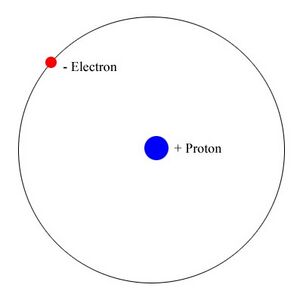User talk:KimberlyWynne: Difference between revisions
| Line 39: | Line 39: | ||
a biological cell, a cluster of galaxies, the Earth, a galaxy, the Local Group of galaxies, a neutron, a neutron star, a person, the Solar System, our sun. Note: you may have to look in other books besides your textbook to get all this information. | a biological cell, a cluster of galaxies, the Earth, a galaxy, the Local Group of galaxies, a neutron, a neutron star, a person, the Solar System, our sun. Note: you may have to look in other books besides your textbook to get all this information. | ||
# Neutron = <math>3 quarks \;</math> (or <math>r \approx 1 fm = 10^{-15} m \;</math>) <ref>Which is larger, the proton or the neutron? http://www.physlink.com/education/AskExperts/ae570.cfm</ref> | # Neutron = <math>3 quarks \;</math> (or <math>r \approx 1 fm = 1.113284057367 \times 10^{-15} m \;</math>) <ref>Which is larger, the proton or the neutron? http://www.physlink.com/education/AskExperts/ae570.cfm</ref> <ref>What are the sizes of protons neutrons and electrons? http://wiki.answers.com/Q/What_are_the_sizes_of_protons_neutrons_and_electrons</ref> <ref>On the Radius of the Neutron, Proton, Electron and the Atomic Nucleus http://www.wbabin.net/physics/yue.pdf</ref> | ||
# Atom = empirical atomic radius <math>r \approx 62 - 520 pm = 62 - 520 \times 10^{-12} m \;</math> <ref>Information about Atomic Radii: http://www.webelements.com/</ref> <ref>J.C. Slater, ''J. Chem. Phys.'' 1964, '''41''', 3199.</ref> | # Atom = empirical atomic radius <math>r \approx 62 - 520 pm = 62 - 520 \times 10^{-12} m \;</math> <ref>Information about Atomic Radii: http://www.webelements.com/</ref> <ref>J.C. Slater, ''J. Chem. Phys.'' 1964, '''41''', 3199.</ref> | ||
# Biological Cell = <math>10 \mu m \;</math> <ref>Campbell, Neil A.; Brad Williamson; Robin J. Heyden (2006). [http://www.phschool.com/el_marketing.html Biology: Exploring Life]. Boston, Massachusetts: Pearson Prentice Hall. ISBN 0-13-250882-6</ref> | # Biological Cell = <math>10 \mu m \;</math> <ref>The Biological Cell on Wikipedia http://en.wikipedia.org/wiki/Cell_(biology)</ref> <ref>Campbell, Neil A.; Brad Williamson; Robin J. Heyden (2006). [http://www.phschool.com/el_marketing.html Biology: Exploring Life]. Boston, Massachusetts: Pearson Prentice Hall. ISBN 0-13-250882-6</ref> | ||
# Person | # Person | ||
# Earth | # Earth | ||
Revision as of 01:46, 9 September 2009
- Use this page to discuss whether or not (or how much) Kim Wynne is actually awesome.
- Sorry
- I
- can't
- help
- myself
- MatthewHoza
| ||||||||
Homeworks 1 is the attempted solution to our second task[1] in the course Introduction to Astrophysics. This assignment is due on Wednesday 09/09/09 and was assigned on 09/01/09.
Problem 1
List in order of increasing size and give the approximate size of the following objects: An atom, a biological cell, a cluster of galaxies, the Earth, a galaxy, the Local Group of galaxies, a neutron, a neutron star, a person, the Solar System, our sun. Note: you may have to look in other books besides your textbook to get all this information.
- Neutron = (or ) [2] [3] [4]
- Atom = empirical atomic radius [5] [6]
- Biological Cell = [7] [8]
- Person
- Earth
- Sun
- Neutron Star
- Solar System
- Galaxy
- Local Group of Galaxies
- Cluster of Galaxies
Problem 2
The nearest star outside the solar system is about 4 light years away.
- How far away is the star in kilometers?
- Suppose you travel to the nearest star in a rocket ship moving at 100 km per hour (100 km/hr is
about 62 mi/hr, a typical automobile speed on a Florida highway). How many years will it take you to get to the star?
- Suppose you travel to the star at 10 km per second (the speed of a rocket in orbit around the Earth). How many years will it take you to get to the star?
Problem 3
Use the size of the Astronomical Unit in kilometers and the length of the year in seconds to calculate how fast the Earth moves in its orbit in kilometers/second.
Problem 4
Describe the essential differences between the Ptolemaic, Copernican, and Keplerian descriptions of planetary motion.
Problem 5
Use Newton’s laws to show that the orbits of planets are ellipses.
Notes
- ↑ Our first task was to register our PRS, visit the course web-page on Blackboard, look at the textbook, and write an equation for our wiki
- ↑ Which is larger, the proton or the neutron? http://www.physlink.com/education/AskExperts/ae570.cfm
- ↑ What are the sizes of protons neutrons and electrons? http://wiki.answers.com/Q/What_are_the_sizes_of_protons_neutrons_and_electrons
- ↑ On the Radius of the Neutron, Proton, Electron and the Atomic Nucleus http://www.wbabin.net/physics/yue.pdf
- ↑ Information about Atomic Radii: http://www.webelements.com/
- ↑ J.C. Slater, J. Chem. Phys. 1964, 41, 3199.
- ↑ The Biological Cell on Wikipedia http://en.wikipedia.org/wiki/Cell_(biology)
- ↑ Campbell, Neil A.; Brad Williamson; Robin J. Heyden (2006). Biology: Exploring Life. Boston, Massachusetts: Pearson Prentice Hall. ISBN 0-13-250882-6
References
- B.W. Carroll & D. A. Ostlie (2007). An Introduction to Modern Astrophysics. Addison Wesley. ISBN 0-8053-0402-9




